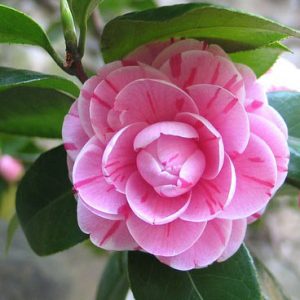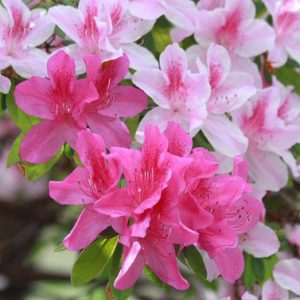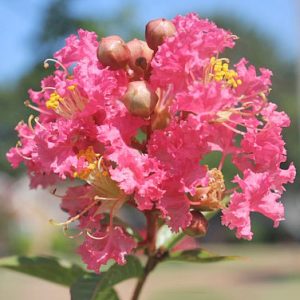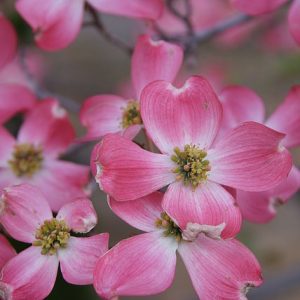×
Spring has sprung in Charleston, as evinced by all the beautiful blooms sprouting in area gardens and parks. When planning your own landscape design, be sure to include plants that are well-adapted to the area. They not only blend well aesthetically with other local flora, but more importantly, thrive in the environment.
The South Carolina Lowcountry is conducive to many plant types, from massive Live Oak trees adorned with Spanish moss that add a canopy of shade, to Southern Pines, to a number of spectacular ornamentals and unique grasses. Here are a few excellent choices for plants that not only do well in the Charleston-area climate, but also add beauty to your home.
 These moderately tall shrubs boast colorful flowers that bloom in the winter. One of the most appealing attributes of the camellia family is that they are evergreen. In the Lowcountry climate, the leaf portion of stays green year-round.
These moderately tall shrubs boast colorful flowers that bloom in the winter. One of the most appealing attributes of the camellia family is that they are evergreen. In the Lowcountry climate, the leaf portion of stays green year-round.
While there are more than 3000 individual varieties across the US South, the Japanese Camellia (Camellia japonica) is most popular around Charleston. It was brought to the New World late in the 18th century by French botanist Andre Michaux and earned the name the “Rose of Winter.”
The camellia proves hardy in hot Lowcountry summers, and supplies a vibrant show of color through the winter months. You’ll see versions in hot pink, to pale pink, to white, and combinations of those colors. Many of the shades are the perfect landscape compliment to the primary colors of azaleas. Camellias also come in varieties that produce double flowers.
If you would like to see thousands of camellias in bloom, be sure to attend one of Middleton Place’s camellia walks. These free guided tours take place in early February each year, when the flowers are at their most spectacular. You’ll even visit the 1786 Reine des Fleurs, one of the first camellias planted in America.
Did you know that tea leaves come from a camellia? The Camellia sinensis also grows well in the Lowcountry. You can even tour America’s only tea producer, the Charleston Tea Plantation on Wadmalaw Island. Here, you’ll see fields of the plants growing – and if you come at the right time, even being harvested. While there, be sure to sample some American Classic Tea.
 The azalea has provided the most popular spring color display in South Carolina for centuries. Each spring, thousands of avid fans across the south flock to Summerville’s Flowertown Festival to see the blossoms at their peak.
The azalea has provided the most popular spring color display in South Carolina for centuries. Each spring, thousands of avid fans across the south flock to Summerville’s Flowertown Festival to see the blossoms at their peak.
While some cultivators across Charleston are indigenous, others were imported from the Orient. The azalea finds an ideal home in the shade under native Live Oak trees. The pH soil levels in the Lowcountry are also next to perfect for growing massive clusters of azaleas.
The shallow root systems of nearly all azalea varieties are excellent for providing quick moisture from minimal rainfall. In isolated landscape planters, some irrigation can be helpful during long dry spells. They rarely need pruning, except in situations where shaping or containment are desired.

The crepe myrtle is a flowering shrub that can also grow to heights classified as a tree. Like the camellia and azalea, Lagerstroemia indica has a number of cultivators, many brought to the US from parts of Asia.
The name is indicative of the crepe paper-like bark that covers the tree's trunk. As a crepe myrtle grows more mature, the light and dark spots on the trunk become an important part of its visual appeal. The pink, purple, or white flowers are equally as breathtaking.
Frequently, crepe myrtles are cut back in the late fall and allowed to winter over with virtually no top portion. During the next spring, shoots of limbs multiply. As the smaller crepe myrtles grows into trees, they provide a color spectacle that can last the better part of the Lowcountry summer.
 Another species of flowering landscape foliage prevalent in the Lowcountry is the dogwood tree. Many native species grow wild in surrounding wooded areas. The two most common colors of its flowers are pink and white. Old dogwood trees often have an under layer of azaleas augmenting their spring display. The dogwood’s flowering is a signal of spring.
Another species of flowering landscape foliage prevalent in the Lowcountry is the dogwood tree. Many native species grow wild in surrounding wooded areas. The two most common colors of its flowers are pink and white. Old dogwood trees often have an under layer of azaleas augmenting their spring display. The dogwood’s flowering is a signal of spring.
While not quite as visible as the bark of the crepe myrtle, the dogwood also has a unique texture to its trunk. As the trees mature, definitive bark grain begins to help foretell the years the tree has been alive.
Many historic homes in and around Charleston are as known for their fantastic gardens as they are for the actual house. Next time you are strolling through downtown Charleston, be sure to notice these popular landscape trees. Together with annual and perennial flowers, they keep Charleston blooming in vibrant color.
Monday to Friday: 9:00 am - 5:00 pm
Copyright © 2025 Disher, Hamrick & Myers, Inc. All Rights Reserved.
Website Design by OBS